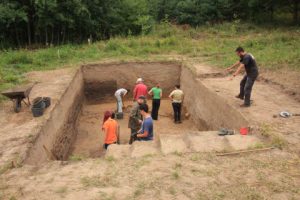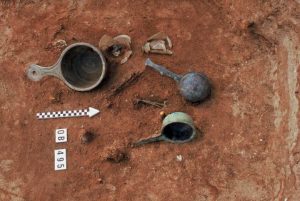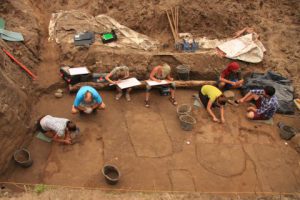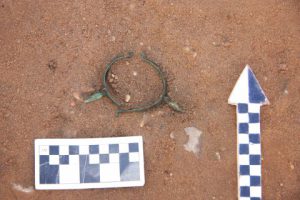Project information
Project title: Weklice, site 7, Elbląg comm. The cemetery of Roman Period elite in the centre of amber coast
Project lead: dr Magdalena Natuniewicz-Sekuła
Project lead, institutional: Instytut Archeologii i Etnologii PAN, Ośrodek Archeologii Średniowiecznej Krajów Nadbałtyckich
Project financing: Narodowe Centrum Nauki
Contact:
e-mail: m_natuniewicz@yahoo.com
telefon: 22 620 28 81
Project implementation
Institutions involved:
Institute of Zoology, Department of Anthropology, Jagiellonian University
Institute of Textiles Architecture, Technical University in Łódź
Bio- and Archaeometry Laboratory of IAE PAN in Warsaw
Scottish Universities Environmental Research Centre, Glasgow University
Department of Clinical Anatomy; Department of Biochemistry and Chemistry, Department of Forensic Medicine,Pomeranian Medical University
Department of Radioisotope, Silesian Technical University in Gliwice
Poznań Radiocarbon Laboratory
Researchers involved::
PhD Magdalena Natuniewicz-Sekuła (Institute of Archaeology and Ethnology IAE PAN)
Scope of responsibilities:
- descriptive catalogue of grave and features; summary of specialist analysis; preparing of the manuscript monograph
M.A. Agnieszka Bocheńska (Department of Archaeology; The Royal Castle in Warsaw)
Scope of responsibilities:
- digitalization of field documentation (plans and profile of features); computer graphic design field documentation; computer graphic design illustrating the graves equipment with their plan and profiles
PhD Beata Cienkosz-Stepańczak (Institute of Zoology, Department of Anthropology, Jagiellonian University
Scope of responsibilities:
- isolation of isotopes of carbon, nitrogen and oxygen from osteological material and elaborating of results analysis
Dr engineer Maria Cybulska (Institute of Textiles Architecture, Technical University in Łódź)
Scope of responsibilities:
- analysis and technological expertise’s of textile remains
M.A. Marta Dec (State Archaeological Museum in Warsaw)
Scope of responsibilities:
- scientific reconstruction of clay vessels with description of pottery manufacturing technology
M.A. Maria Michniewicz (Institute of Archaeology and Ethnology IAE PAN)
Scope of responsibilities:
- botanical analysis of wood remains
M.A. Ewa Pazyna
Scope of responsibilities:
- drawings in ink small finds and pottery vessels
M.A. Jarosław Strobin (Archaeological Museum in Gdańsk)
Scope of responsibilities:
- analysis and expertise execution techniques and technology of metal finds (iron, copper alloys, precious metal)
PhD Iwona Teul (Department of Clinical Anatomy, Pomeranian University in Szczecin)
Scope of responsibilities:
- anthropological analysis (age, sex, height), palepathology analysis of cremation and skeletal remains, elaboration of results biochemical and DNA research
Characteristic
Research objective:
The main aim of the project is through multi-faceted specialist analyses with the involvement of interdisciplinary research scientific description and prepress the newest results of the excavations at the largest in Europe biritual cemetery of Wielbark Culture at Weklice, site 7, Elbląg comm., Warmińsko-Mazurskie voiv., located on the Elbląg Heights. According that, the project involves the dissemination of sources of high scientific value by creating unique scientific workshop. To the present, the first volume monograph of the cemetery was published in the international book series Monumenta Archaeologica Barbarica, including a few pre-war finds and graves and features from the excavations in the years 1984-2004. Discovered in 2005-2013 another ca 120 graves with over of 1200 finds made of precious metals, iron, copper alloys, amber, glass, clay and wood are the main study subject of this project. The excavation of this cemetery (functioning around I-IV century AD), also provided important and abundant anthropological sources and helped to make innovative observations on the anthropological structure of the community buried here. On the other hand the remains of botanical remains and textiles allowed for interesting observations on the forms of the graves, traces of funeral rite and characteristics of ceremonial attire. The cemetery at Weklice located in the center of the amber coast and then crossing of trade routes is undoubtedly the burial ground with an exclusive character. Evidence of this wealth are grave goods, both local and imported i. a. from Roman Empire, Scandinavia and the Black Sea areas. The study of these materials is planned in form of partial synthesis as a detailed specialist analyses with the participation of experts from natural and exact sciences. It should be made clear that the study of this specific and also a variety of archaeological sites as cemeteries is a multidisciplinary effort. It requires the cooperation of professionals from various fields as i.a. anthropology, denistry, radiology, biochemistry, genetics and many others.
The project schedule:
1. Specialized analyses of the material from Weklice cemetery: anthropological, technological of finds (metals, pottery, textiles) with the study of the chemical composition, botanical, C14
2. Descriptive and illustrative catalogue of graves and features from Weklice cemetery (seasons 2005-2013), including synthetic results of the specialist analyses Institute of Archaeology and Ethnology Polish Academy of Sciences
Planned results:
The result of the project will be the preparation of the manuscript monograph.
News
Year 2014:
In 2014, the following activities related to the project were done: 1. Analysis and elaboration of botanical taxonomic terms and organics wood samples obtained during research seasons in the years 2005 to 2013 in the cemetery of Wielbark Culture at Weklice; 2. The scientific reconstruction dozens forms of pottery from the research seasons from 2008 to 2009; 2011 to 2013 with a description of the technology of ceramics; 3. Elaboration scientific descriptive catalogue of graves and features from seasons 2005 to 2006; 4. Supplementary graphics digitalization field documentation (plans and profiles of objects) discovered during research seasons of the years 2005 to 2013; 5. Complementary graphic illustration of finds (metals, glass, amber, clay), discovered in research seasons from 2008 to 2009.
Year 2015:
– further work on the implementation of tasks within the project schedule
– participation in international symposium „10th International Symposium on Knappable Materials. On the Rocks”. University in Barcelona (7-12 September 2015).
A paper on the materials developed within the project delivered by dr Magdalena Natuniewicz-Sekuła and dr Dagmara H. Werra, entilted Flints in Iron Age graves. Flints from the cemetery at Weklice Elbląg country, Elbląg district, northern Poland.
Publications
Magdalena Natuniewicz-Sekuła, Dagmara H. Werra
2014 Materiały krzemienne z cmentarzyska kultury wielbarskiej w Weklicach, stan. 7, pow. Elbląski, Wiadomości Archeologiczne, t. LXV, s. 197-210








